20 Jun 2013
St. Louis: Winner and Still Champion
With the world premiere of Champion, the enterprising Opera Theatre of Saint Louis set the bar very high indeed for the summer festival season.

With the world premiere of Champion, the enterprising Opera Theatre of Saint Louis set the bar very high indeed for the summer festival season.
The new work by jazz great Terence Blanchard (music) and playwright Michael Cristofer (libretto) has all the elements to make a fine opera: a flawed but towering hero, a story with larger-than-life issues, a first class staging, contemporary appeal, and a uniquely imaginative score that is immediate and accessible
James Robinson has staged Champion with all of his customary visual bravura balanced by insightful exploration of the complex central character, real life boxer Emile Griffith. The pugilist critically injured an opponent during a televised match in 1962 and it altered his life. The story is offered in ten scenes (or ‘rounds’) book-ended by the present day man who is in assisted living and suffering from dementia.
The creators have divided the title role between three actors: Arthur Woodley as the retired Emile Griffith, Aubrey Allicock as the young champion, and Jordan Jones as the boy Emile. All are excellent. If Mr. Allicock proves to be the evening’s breakout star, Mr. Woodley is unquestionably the show’s rock.
Woodley received the most sustained, vociferous ovation of the festival for a Herculean performance that combined beautifully delineated phrases, flawless coloring of the text, orchestra-riding power in arching outbursts, and a well-rounded embodiment of the troubled, fading, rather gentle giant. Arthur Woodley has unequivocally defined the role for future interpreters
No less impressive was the amiable, self-assured performance by Mr. Allicock, as notable for his uninhibited physical commitment as it was for his uniformly suave singing. His mellow bass sound and forward placement fell pleasantly on the ear. More than any other soloist, Aubrey selectively emulated a more pop delivery, dropping the focus out of the mask. This lent variety to the style but I am not sure it was necessary to the success of the score. But never you mind, I predict Aubrey Allicock’c career may take off like a rocket
Young Mr. Jordan had far less to sing, but he made a strong impression, his boy soprano pure and present. International mezzo Denyce Graves predictably made a potent contribution to the evening’s success as the fighter’s mother. As ever, Ms. Graves looked glamorous and gifted us with smokey-hued, effusive tone, especially in the lower and mid-range. In the highest stretches, the singer husbanded her resources effectively but one or two extreme notes were touched on rather than floated. She scored big with one of the opera’s best set pieces, a long lament that found her voice soaring and plunging over the bare accompaniment of a pizzicato bass, to mesmerizing effect
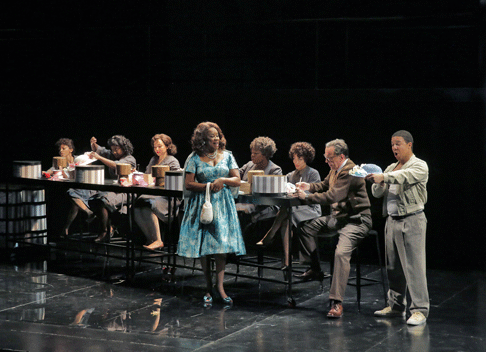 (L to R) Denyce Graves as Emelda Griffith, Robert Orth as Howie Albert, Aubrey Allicock as Young Emile Griffith, and members of the company of Opera Theatre of Saint Louis
(L to R) Denyce Graves as Emelda Griffith, Robert Orth as Howie Albert, Aubrey Allicock as Young Emile Griffith, and members of the company of Opera Theatre of Saint Louis
Established contralto Meredith Arwady made the most of a featured role as owner of a drag bar, and her meaty voice lustily encompassed a bluesy ‘hot mama’ number. In look and delivery she seemed to be channeling Broadway’s Debra Monk. Young artist Chabrelle Williams made a notable impression as the boxer’s wife, her limpid, vibrant soprano utilized with pristine polish. Brian Arreola’s lean, well-schooled tenor and his impassioned way with several high-flying phrases were perfectly matched to the role of the sympathetic care-giver Luis. Roberth Orth brought his wealth of experience to bear as the trainer, and he sang with real fire and commitment
In dual roles, Victor Ryan Robinson infused his high tenor with real personality as the taunting, doomed opponent; and sang with aching beauty in the final confrontation as the victim’s son. In the important role of the young man in the bar who awakens Emile’s homosexual feelings, Lorenzo Miguel Garcia made each phrase count
At a time when most companies seem clinically afraid to program new works, OTSL seems afraid not to. It is deeply ingrained in their mission. Since 1976 they have offered twenty-three world premieres, an equal number of American premieres and major revivals of seven American operas, an awesome record by any standard.
The organization has mounted this new piece without stinting, to include providing a colorful multi-set design from Allen Moyer. The uses of levels, the star reveal for Ms. Graves in a vintage car, the seedily sequined bar, the fanciful hat factory, and the very theatrical evocation of the boxing ring, were deftly balanced with the reality of the hero’s current institutional ‘prison.’ The effective sliding panels were also used to accommodate Greg Emetaz’s eye-catching video and still projections. Christopher Akerlind’s tight specials served the concept well, and James Schuette out-did himself with character specific costumes that contributed colorful period commentary.
Mr. Cristofer’s libretto sometimes spends more time in spoken dialogue than it may need to, and it occasionally strains a little hard to be vulgar, but he has given the composer a wonderful format with his episodic approach, fluid timelines, and layering of characters. Mr. Blanchard has responded with a score that has echoes of everything from Harry Connick’s Broadway work to Shostakovich to Adams, but despite discerning a few fleeting influences, the score remains true to Blanchard’s unique sound.
George Manahan drew sensitive playing from the pit, but the score seems to use the instrumentalists more as a buoyant cushion of harmonies and propulsive percussion that an equal partnership (the orchestration was developed in part by Howard Drossin). With further performances, I would suspect there may be some tweaking and shaping, but as it stands the opera already has legs and memorable numbers, witness a remarkable quartet in Act Two. And the heart-wrenching final moments as Emile recalled his opening thoughts about his missing shoe. Yes, it lives up to its advance press: OTSL has a hit on its hands.
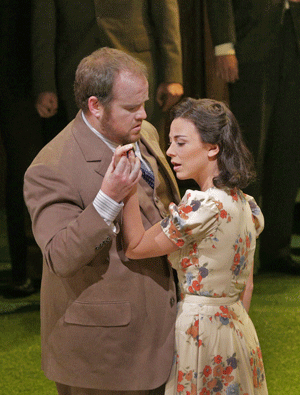 (L to R) Garrett Sorenson as Lukáš and Corinne Winters as Vendulka
(L to R) Garrett Sorenson as Lukáš and Corinne Winters as Vendulka
Smetana’s The Kiss also delivered the goods in a wholly different genre. It is hard to imagine why this lovely composition has had so little traction outside of the Czech Republic, for it offers as much effervescent fun as Bartered Bride with two stellar roles for soprano and tenor, and supporting turns with intriguing music that afford entertaining opportunities.
Okay, okay, so the plot is slight. The heroine, Vendulka, agrees to marry a widower Lukas, but refuses to kiss him before the wedding. And then, two acts later, she relents. But during those two acts, that act of defiance sparks pages and pages of fun stuff, with evocative orchestral writing (like the sunrise) that are equal to Smetana’s best. Director Michael Gieleta’s ingenious staging mined all of the dramatic (or more to the point, comic) possibilities in the rather uncomplicated tale
James Macnamara’s lean set design featured floor-to-ceiling panels of vertical wooden planks with various dimensions and textures, and a floor covered by a verdant green Astroturf, a stylized suggestion of the Czech countryside. With the addition of a few well-crafted set pieces (to include some goofy over-sized sunflowers), the environment was fanciful and functional. Mr. Akerlind’s skillful lighting with its gobos and washes added another level of refinement, and Fabio Toblini’s lovingly rendered folk costumes pushed the physical production up yet another notch to a resounding visual success. It should be reported that throughout the festival, Tom Watson made significant contributions with his distinctive hair and elaborate make-up designs
Anthony Barrese drew particularly fine playing from his St. Louis Symphony musicians who reveled in the richness and lyrical detail of Smetana’s writing. At times there were even potent suggestions of Wagner, such as in the superlative sustained “sun” passages. Maestro Barrese’s assured reading winningly rendered all of the sprightly folk elements, and he shaped the performance with stylistic acumen
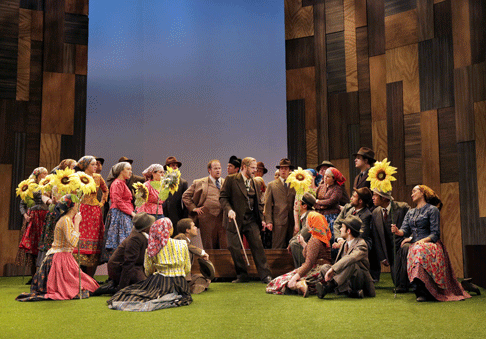 (Center, L to R) Garrett Sorenson as Lukáš, Matthew Burns as Palouký Otec, Matthew Worth as Tomeš and members of the company in Opera Theatre of Saint Louis
(Center, L to R) Garrett Sorenson as Lukáš, Matthew Burns as Palouký Otec, Matthew Worth as Tomeš and members of the company in Opera Theatre of Saint Louis
As Vendulka, Corinne Winters soundly demonstrated that she has made good on all the wonderful promise she displayed in seasons past. Ms. Winters struck just the right balance between the girl’s stubbornness and the soft core that it conceals. Her singing above the staff was laser-perfect, thrilling in its lustrous intensity. Her substantial soprano also speaks well in the lower ranges where a hint of darkness ensures good projection, though occasionally at the cost of the diverse palette of colors she has at her command in the upper half of her instrument. In all respects, this was a decisive performance
Garrett Sorenson’s Lukas more than held his own against this adamant kiss-denier. He has a boyishly appealing demeanor and a hefty tenor of gleam and thrust. His technique is secure and free, and when he pours out the sound there is ample stentorian power on display. But Mr. Sorenson also did some ravishing, tormented phrases that he underplayed with moving results. Indeed, his overall excellence made me wonder (hope?): is a superb Peter Grimes possibly in our midst?
Matthew Worth’s refined baritone has been on display at any number of the nation’s high profile assignments recently and with good reason: his bright, fresh baritone, virile and buzzy in lower patches, sails easily up to tenor territory seemingly at will. As Tomes, he cuts a fine figure, relaxed and appealing. Gerdine Artist Charles Z. Owens showed off a bass of real quality as the “old” smuggler Matous, and he was wisely allowed to use his lean young frame, perfect comic timing, and puppy dog energy to enliven the proceedings. Nor was Elizabeth Barton the right age for Vendulka’s “aunt” Martinka, but Ms. Barton’s plummy, generous mezzo compensated nicely. Emily Duncan-Brown as the servant Barce only had one big aria, but she sang it for all it was worth and her silvery lyric delivery was enchanting. Matthew Burns’ incisive bass and concentrated delivery brought an electric charge to his every scene as the crotchety father. Robert Ainsley’s choral preparation was full-throated and meticulous. The smugglers’ “all clear” chorus was a model of diction and control
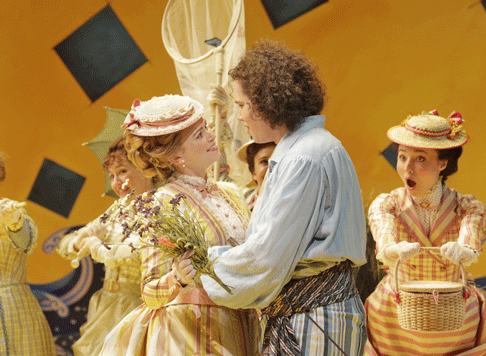 (L to R) Deanna Breiwick as Mabel, Matthew Plenk as Frederic, and members of the chorus in Opera Theatre of Saint Louis
(L to R) Deanna Breiwick as Mabel, Matthew Plenk as Frederic, and members of the chorus in Opera Theatre of Saint Louis
I would be hard pressed to imagine a livelier, more colorful, better sung (and played) Pirates of Penzance than the thoroughly delightful production inhabiting the stage of the Loretto-Hilton. The invigorating pace, the unbridled good spirits, and the spot-on comic delivery threatened to permanently impose a broad grin on my face.
The Dream Team responsible for so fully realizing this G&S confection was led by the accomplished director-choreographer Seán Curran. Mr. Curran built on the resounding successes he has given us in past seasons (most especially a vivacious Daughter of the Regiment) and he now knows the venue inside out. His blocking took full advantage of the thrust configuration and his inventive comic touches landed with breezy regularity.
If the choreography of Act One’s finale suddenly abandoned character-based movement and morphed into (well-executed) Broadway jazz squares, and if the stage business nearing the end of Two descended into almost relentless busy-ness, what the hell, tell that to the belly laughing audience who ate it all up with a spoon. Seán knew what he was doing, and what he was doing was very very crowd-pleasing. By the time Queen Victoria herself made an unscheduled appearance, we willingly followed him anywhere he led
James Schuette’s vibrant setting was at first all warm gold tones set off by accents of blue squares, backed by stylized waves, and featuring a sort of pop-up-book pirate ship of various rolling components. And all this was set off by a lavish gold proscenium arch with rich red drape, and topped by a skull and crossbones crest for a perfect establishment of time, place, and performance style. For the second act, a star curtain proved an effective backdrop for a Hollywood-esque graveyard that was a clever environment to suggest ancestors, heritage, and comically ominous plot development. Mr. Schuette excelled even more with his glorious period costumes, properly lavish for the high born, prankish for the pirates, and aptly Keystone-ish for the Kops
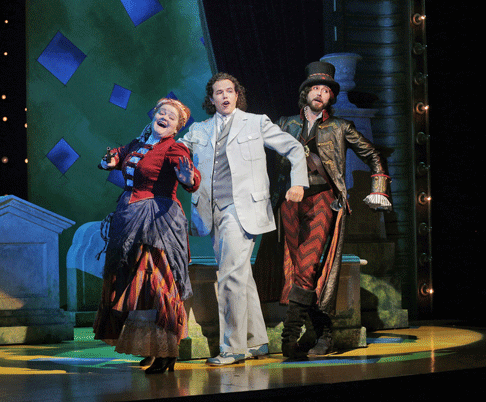 (L to R) Maria Zifchak as Ruth, Matthew Plenk as Frederic, and Bradley Smoak as the Pirate King
(L to R) Maria Zifchak as Ruth, Matthew Plenk as Frederic, and Bradley Smoak as the Pirate King
Tom Watson arguably did his best work here, which is to say some of the best wig and make-up work in the business. The young ladies were impeccable coiffed, the pirates suitably scruffy, and Ruth’s transformation was telling and visually engaging. Christopher Akerlind’s lighting was so effective as to seem effortless
In the pit young conductor Ryan McAdams kept everything bubbling and effervescent, never letting the mood descend into overt sentimentality. Maestro McAdams controlled his large forces with skill (as in the sublime amassed choral passages, thank you again Mr. Ainsley), and kept a tight rein on the numerous stretches of perilous patter
If his current over-the-top performance is any indication, Bradley Smoak could own the part of the Pirate King. His vocal accomplishments certainly set the standard for polished singing of the role, and he uses his good looks and lanky physique to superb comic effect. There is not a “take” that goes amiss, not a twitch of his sword that is not well-considered, and his light-footed traversal of Mr. Curran’s dance steps was assured and appealing. Has any King besides Bradley ever executed high kicks like a seasoned hoofer? Mr. Smoak dominated the stage with a performance of consummate wit, inspired clowning, resonant singing, and star power to spare.
No other role in the piece affords quite the some over-sized opportunity, but that didn’t stop the rest of the cast from making mighty impressions. Matthew Plenk was a model Frederic, strapping, boyish, and possessed of a meaty, pliable tenor that could not only caress a phrase with warmly sublime tone, but could also summon up reserves of clarion power to make it quite believable that he could literally bowl young ladies over as the staging suggests. Deanna Breiwick was cute as a button as Mabel, and her honeyed soprano was up to all the role’s technical demands as she dispatched the tricky parodies of operatic coloratura with precision and ease
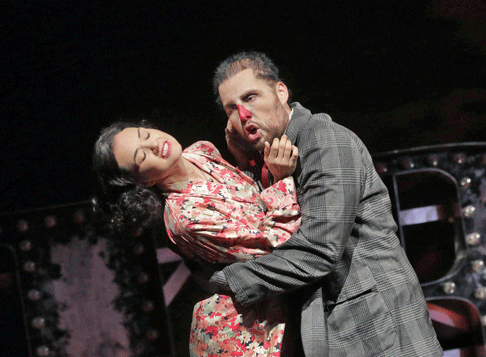 Kelly Kaduce as Nedda and Tim Mix as Tonio
Kelly Kaduce as Nedda and Tim Mix as Tonio
Seasoned performer Maria Zifchak was luxury casting as the anything-but-matronly Ruth, her ripe mezzo enlivening and enriching the part beyond its usual interpretation. The success of General Stanley usually rises or falls on the enunciation of the rapid-fire text to his world famous patter song, and Hugh Russell’s nimble delivery did not disappoint. His wiry, fidgety persona and pleasing baritone did much to flesh out a well-rounded character. Jason Eck used his solid stature to good advantage as a determined Police Sergeant, and he showed off a fresh, sterling vocal production that was more baritone than bass. Mr. Eck shone in the middle to high registers, but the awkward writing in the extreme lows of the range were a bit less impressive
Jaime Korkos (Edith), Corrie Stallings (Kate), and Katrina Galka (Isabelle) made solid impressions in their featured moments, acting with real commitment and defined purpose, and singing with effortless aplomb. Tobias Greenhalgh’s well-schooled baritone lent fine support as Samuel, and his inspired swaggering and comic capabilities suggest he himself may be a Pirate King in the making. The accomplishment of all four of these exceptional young performers once again makes a potent testament to the depth and success of OTSL’s Gerdine Young Artist program
The idea of pairing the verismo operas Il Tabarro (Puccini) and Pagliacci (Leoncavallo) may not be new but it remains a potent match-up. Both pieces treat stories of ill-fated love triangles that culminate in sudden violent retribution. It was wise to place the more famous opera second and doubly wise to seek out experienced vocal practitioners who had the chops to fulfill the musical demands. Curiously, although director Ron Daniels stage both works, they seemed to spring from two different sensibilities and skill sets
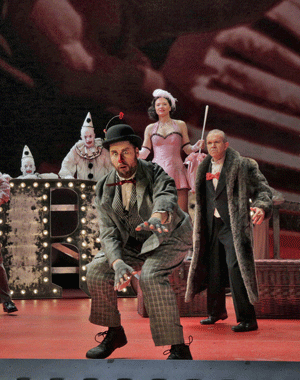 (L to R) Tim Mix as Tonio, Kelly Kaduce as Nedda, and Robert Brubaker as Canio
(L to R) Tim Mix as Tonio, Kelly Kaduce as Nedda, and Robert Brubaker as Canio
Pagliacci (The Clowns) was a marvel of controlled tension, passions seething just below the surface, intense encounters, complex character development, and specificity of actions. Conversely, Il Tabarro (The Cloak) was generically flat with slight chemistry between the performers, no discernible heat or subtext supporting the words, and implausible physical placement such as having Giorgetta and Luigi singing full voice to each other across the width of the stage when they should have been hissing conspiratorial comments to each other under their breath in close proximity
Although director Daniels made use of the entire auditorium as a playing space for both shows, in Pagliacci it was integral, in Tabarro it felt gratuitous. That he is an accomplished director was amply evidenced by the highly detailed work in the second piece, making his intentions in the first seem a puzzling, deliberate choice
The cast was up to their assignments. Emily Pulley has a plush, throbbing, responsive soprano that is a perfect match for the demands of the unhappy Giorgetta. While at full throttle she seemed to be intent to fill a house three times the size of the current venue, she has the means to do it. Her more conversational passages had equally great presence and import. On other occasions, I have seen Ms. Pulley delve more deeply into a character, and Giorgetta is this opera’s most complex personality. In future outings I might urge her to dig deeper. Tim Mix was a bit young for the role of Michele, both in vocal personality and maturity. Mr. Mix has a rolling baritone of natural beauty and pristine production. His instrument is thrillingly even up and down the range. What he could not quite yet suggest was the world-weariness or dangerous resolution necessary to inform the drama
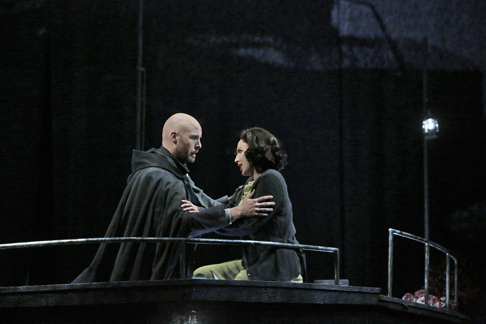
On the other hand, Robert Brubaker’s heroic tenor easily encompassed Luigi’s bitter determination, but could not as easily be convincing when it came to communicating youthful ardor. Still, he handled the cruelly exposed and sustained tessitura with reliable professionalism.
The smaller roles were all cast from strength. Matthew DiBattista was a far less wasted Tinca than usual, his tenor ringing out freely. Thomas Hammons brought his experience to bear for a well-sung, characterful Talpa. Arguably the most wholly successful of the principals was Margaret Gawrysiak, whose traversal of the eccentric Frugola was marked by a focussed, joyfully produced mezzo that gave much pleasure. The Gerdine Young Artists reliably filled out the smaller roles, with the sweet-voiced Alexis Aime and Michael Kuhn especially affecting as the pair of strolling lovers
Riccardo Hernandez devised a commendable set design for the double bill, using a grainy black and white photo of a barge as a ‘backdrop’ (hung in the main drape position) for Tabarro fronted by a simple suggestion of the boat deck on the apron. For the Leoncavallo, he opened the stage up and filled it with a large marquee sign Circo that at first lay in state like a relic from the Las Vegas Neon Museum. It spoke volumes about the ruined lives parading before us and practically, it even served as the fence through which Silvio comes and, more important, escapes. Mr. Hernandez adds a few set pieces to complete the improvisatory settings. For the “performance” within the performance, the Circo gets raised and chaser lights sputter to life. A rolling stage comes on, and real theatre seats roll in place. Finishing off the ‘look’ is a huge skewed photo of a rather ominous clown in a surreal blood red and white blow-up.
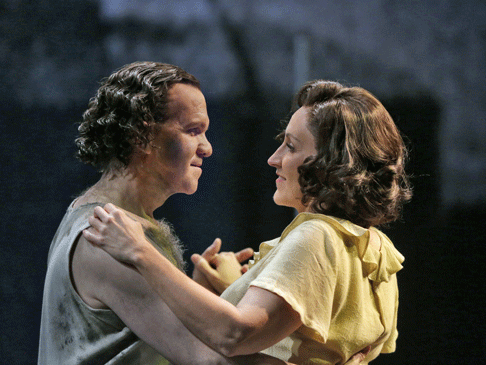 Robert Brubaker as Luigi and Emily Pulley as Giorgetta
Robert Brubaker as Luigi and Emily Pulley as Giorgetta
Several performers did admirable double duty. Mr. Brubaker was back as a coiled spring of a Canio, and he sang with such searing power and total commitment that we forgave the phrase or two that frayed a bit under pressure. Mr. Mix presented an especially well-sung Tonio, although his youthful characterization was more rambunctious than truly menacing. He did reaffirm my thinking that this solid talent is a voice to watch. Mr. DiBattista shone even more brightly as Beppe than he had as Tinca, and his brief Serenade was lovingly voiced. But the evening’s total triumph belonged to our Nedda
Has anyone ever seen a performance of Pagliacci’s heroine that could rightly be called a ‘tour de force’? I didn’t think so. Well, now we have, as the dynamo named Kelly Kaduce swept all before her. That she has a secure, malleable, soprano voice capable of considerable power as well as glowing effects goes without saying. But it is also just possible that Ms. Kaduce is the finest actress on the operatic stage today. There was no milli-second of her completely thought-out performance that was not informed by innovative business and deeply internalized motivation. Kelly combined physical comedy worthy of Lucille Ball, dramatic detailing worthy of Meryl Streep, and sultry beauty worthy of Angelina Jolie. And she sings, too!
In an era where singers, directors, conductors and productions can often seem routinely interchangeable on world stages, Opera Theatre of Saint Louis successfully keeps defining “festival opera.”
James Sohre
Champion
Emile Griffith, Retired: Arthur Woodley; Luis Griffith: Brian Arreola; Young Emile, the Champion: Aubrey Allicock; Emelda Griffith: Denyce Graves; Ring Announcer: Christopher Hutchinson; Howie Albert, Trainer: Roberth Orth; Kathy Hagan, Bar Owner: Meredith Arwady; Cousin Blanche/Sadie Griffith: Chabrelle Williams; Little Emile: Jordan Jones; Young Man in a Bar: Lorenzo Miguel Garcia; Benny “Kid” Paret/Benny, Jr.: Victor Ryan Robertson; Conductor: George Manahan; Director: James Robinson; Set Design: Allen Moyer; Costume Design: James Schuette; Video and Projection Design: Greg Emetaz; Lighting Design: Christopher Akerlind; Sound Design: Rusty Wandall; Wig and Make-Up Design: Tom Watson; Choreographer: Seán Curran; Chorus Master: Robert Ainsley
The Kiss
Martinka: Elizabeth Batton; Vendulka: Corinne Winters; Paloucky: Matthew Burns; Barce: Emily Duncan-Brown; Tomes: Matthew Worth; Lukas: Garrett Sorenson; Matous: Charles Z. Owens; Straznik: Spencer Viator; Echoes: Summer Hassan, Nicole Haslett; Conductor: Anthony Barrese; Director: Michael Gieleta; Set Design: James Macnamara; Costume Design: Fabio Toblini; Lighting Design: Christopher Akerlind; Wig and Make-Up Design: Tom Watson; Choreographer: Seán Curran; Chorus Master: Robert Ainsley
The Pirates of Penzance
Frederic: Matthew Plenk; Pirate King: Bradley Smoak; Samuel: Tobias Greenhalgh; Ruth: Maria Zifchak; General Stanley: Hugh Russell; Edith: Jamie Korkos; Kate: Corrie Stallings; Isabel: Katrina Galka; Mabel: Deanna Breiwick; Police Sergeant: Jason Eck; Conductor: Ryan McAdams; Director and Choreographer: Seán Curran; Set and Costume Design: James Schuette; Lighting Design: Christopher Akerlind; Wig and Make-Up Design: Tom Watson; Chorus Master: Robert Ainsley
Il Tabarro & Pagliacci
Luigi/Canio: Robert Brubaker; Nedda: Kelly Kaduce; Giorgetta: Emily Pulley; Michele/Tonio: Tim Mix; Silvio: Troy Cook; Tinca/Beppe: Matthew DiBattista; Frugola: Margaret Gawrysiak; Talpa: Thomas Hammons; Peasant One: Lorenzo Garcia; Peasant Two: Samuel Schultz; Song Vendor: Spencer Lang; Lover One: Alexis Aime; Lover Two: Michael Kuhn; Offstage Soprano: Leela Subramaniam; Offstage Tenor: Benjamin Werley; Conductor: Ward Stare; Director: Ron Daniels; Set Design: Riccardo Hernandez; Costume Design: Emily Rebholz; Lighting Design: Christopher Akerlind; Wig and Make-Up Design: Tom Watson; Choreographer: Seán Curran; Chorus Master: Robert Ainsley